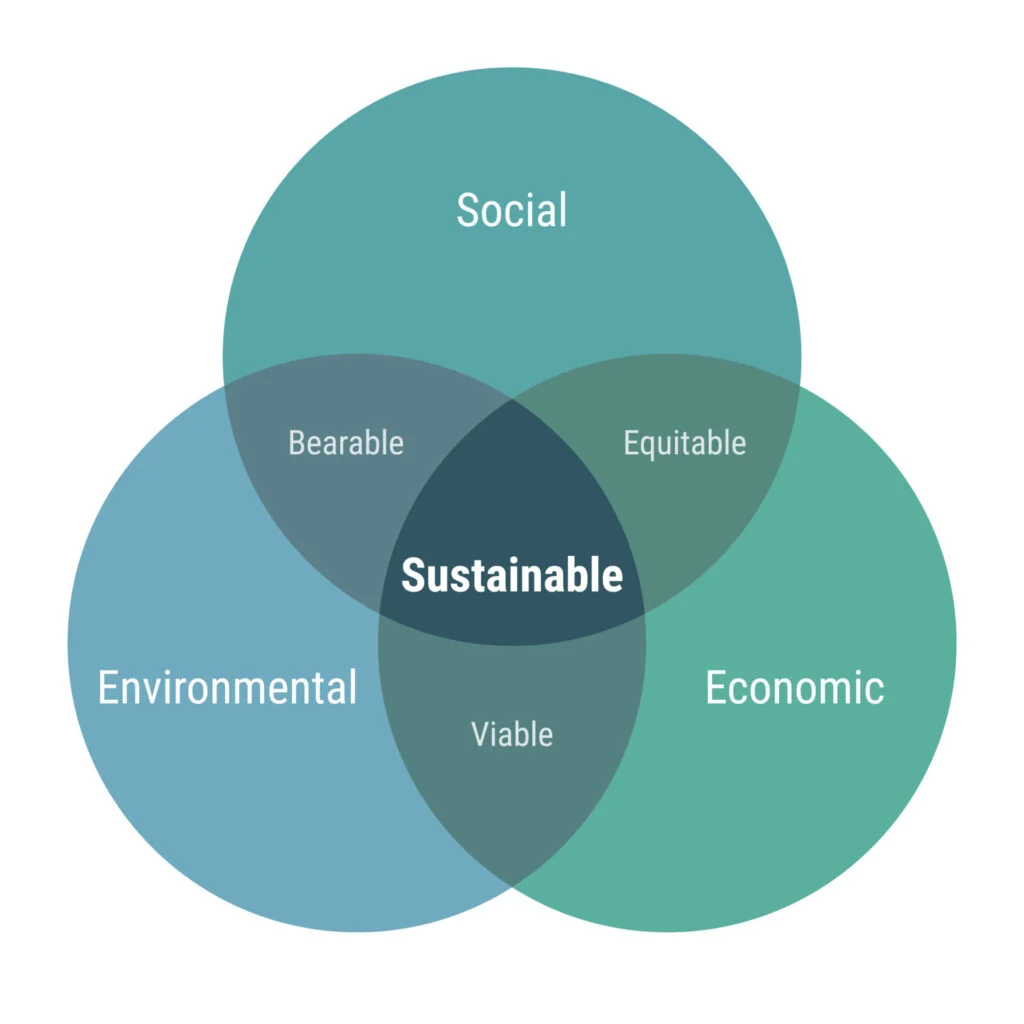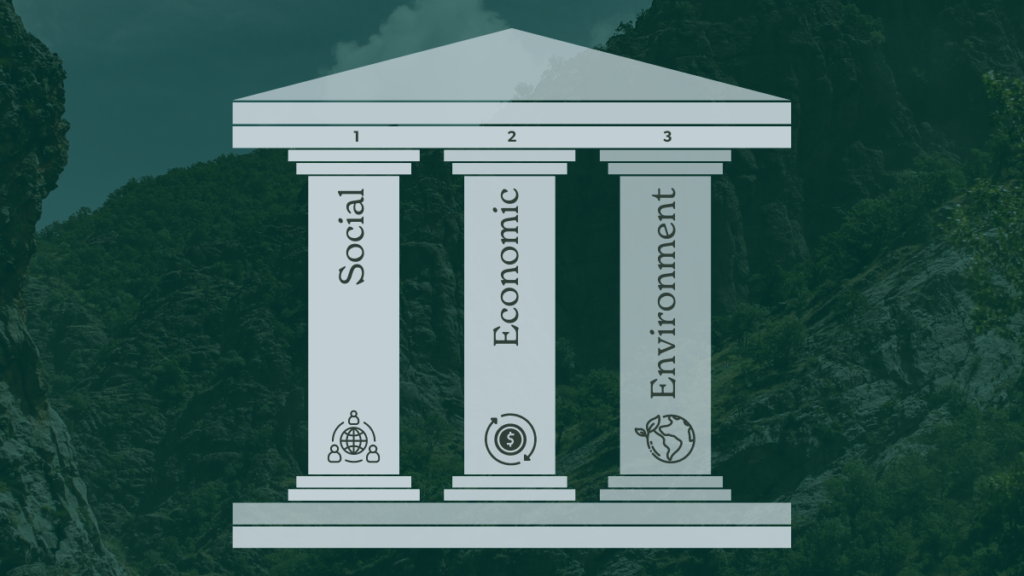Have you ever heard about sustainable development and wondered what it is?
Would you like to know what are the three pillars of sustainability and how you can successfully implement this concept in your company?
In this 10 minute read let us guide you though the three pillars of sustainable development and introduce you to a critical fourth pillar of cultural development. You’ll also get some great ideas on how to implement the sustainability pillars in your organisation.
In an era where environmental degradation and social inequities have become critical global challenges, the concept of sustainability has gained immense importance. Sustainability aims to create a harmonious balance between economic growth, environmental preservation, and social well-being. This holistic approach recognises that long-term prosperity depends on the interdependence of these three pillars. In this article, we delve into the three pillars of sustainability: economic, environmental, and social, and explore their significance in building a resilient future for our planet and its inhabitants.
The definition of sustainable development
In 1987, the UN World Commission on Environment and Development put together a report called the Brundtland Report. The report was more than 300 pages and aimed to help countries create policies to protect the planet and people. The report discussed sustainable development and how to achieve it through things like combating climate change and economic growth. It’s also known as the “Brundtland Report” since it was named after the Prime Minister of Norway, Gro Harlem Brundtland, who led the commission.
“Explaining the three pillars of sustainability first requires defining sustainability. The concept of sustainability arose from environmental activism. It’s taken to mean making sure that the current generation can meet its needs without making it impossible for future generations to meet theirs. That is, we can sustain ourselves and posterity only with practices that do no future harm.”
Sustainable development means building a better world that meets the needs of today’s people without harming the environment or making life harder for future generations. Companies can use it to guide their policies in three important areas: the economy, the environment, and society. To be sustainable, a company must help the economy grow, improve people’s lives, and protect the environment. The most important area is the environment, followed by the economy and society.
Economic Sustainability
Economic sustainability emphasises the need for a thriving and resilient economy that meets the needs of the present generation without compromising the ability of future generations to meet their own needs. Key aspects include:
a) Responsible Resource Management: Encouraging efficient use of resources, minimising waste, and promoting the adoption of renewable and clean technologies. This helps reduce ecological footprints and ensures the availability of resources for future generations.
b) Long-Term Financial Stability: Fostering economic systems that prioritise stability, resilience, and fair distribution of wealth. This involves promoting sustainable business practices, supporting entrepreneurship, and investing in research and development for innovation.
c) Socially Responsible Business Practices: Encouraging businesses to adopt ethical practices, including fair labour standards, safe working conditions, and equitable wages. This ensures that economic growth benefits all members of society, reducing inequalities and promoting social cohesion.
Environmental Sustainability
Environmental sustainability recognises the intrinsic value of the Earth’s ecosystems and the critical role they play in supporting life. It involves preserving and restoring the environment to ensure the well-being of current and future generations. Key aspects include:
a) Conservation and Biodiversity: Protecting natural habitats, conserving biodiversity, and preventing the extinction of plant and animal species. This involves sustainable land use practices, responsible resource extraction, and the establishment of protected areas.
b) Climate Change Mitigation: Addressing the causes and impacts of climate change by reducing greenhouse gas emissions, transitioning to renewable energy sources, and promoting energy efficiency. It also involves adapting to the changing climate to minimise vulnerabilities and enhance resilience.
c) Sustainable Consumption and Production: Encouraging responsible consumption patterns that minimise waste generation, promote recycling, and reduce the use of non-renewable resources. Additionally, promoting eco-friendly production methods and supporting sustainable supply chains are crucial.
Social Sustainability
Social sustainability focuses on promoting equity, justice, and well-being within societies. It recognizes the importance of inclusive and participatory decision-making processes that consider the needs and aspirations of all individuals. Key aspects include:
a) Social Equity: Ensuring fair access to resources, opportunities, and basic services such as education, healthcare, and housing. This involves combating poverty, reducing inequalities, and promoting social justice.
b) Cultural Diversity and Inclusion: Valuing and preserving cultural diversity, promoting inclusive societies, and respecting the rights and identities of all individuals. This fosters social cohesion and strengthens community resilience.
c) Health and Well-being: Prioritising the physical and mental health of individuals and communities. This includes access to clean air, water, and nutritious food, as well as healthcare services, social support systems, and quality education.
What is the diagram of the three pillars of sustainable development?
The three pillars of sustainable development can be illustrated using a diagram to provide a clearer understanding of the greatest challenges facing humanity involved and how they impact one another.

What is the fourth pillar of sustainability?
Many people agree that culture is a crucial part of sustainable development, even though it is not always considered as important as the other three pillars. Culture is related to sustainable lifestyles and carbon emissions in different places, like New York or small islands. Even though it is not seen as a key element, culture is important for sustainable development because it includes the three essential aspects mentioned before.
Culture: the core element of sustainable development
Culture plays an essential role in the journey towards sustainable development. Boasting both social and economic development aspects, culture can provide immense support to the three pillars required for sustainable development. In today’s world, sustainable development culture is routinely disregarded by several companies, however, raising awareness regarding its significance can prove to be genuinely instrumental in carrying out management policies, driving progress across several fronts such as combating poverty, advancing young people’s needs, and enhancing basic services in under-developed countries. As an organisation, prioritising cultural elements can unify human activities, leading to an array of benefits for the company, such as a strengthened sense of community and improved productivity. Apart from economic and social factors, there are indeed four key aspects to sustainable development, including social, economic, environmental, and cultural.
“Culture helps shape our beliefs about how we should interact with each other and our world. It promotes cooperation, togetherness, individual freedoms, and where we should live. Culture is important to the economy and just as crucial to us as nature because it represents our history and traditions.”
Why integrate culture into the pillars of sustainable development?
As previously discussed, culture should be integrated into the pillars of sustainable development predominantly because it encompasses social and economic dimensions. But that is not the only reason, culture can also be employed as an effective strategy to support the three fundamental pillars. It plays a socially-binding and facilitating role in the face of economic, societal and environmental challenges.
Furthermore, the culture of sustainable development (its foundations, its history, its evolution) is often overlooked within companies. More importantly, raising awareness of this culture would provide a better understanding of the issues at stake when implementing management policy (particularly in terms of corporate social responsibility) and encourage greater involvement: such as to eradicate poverty, ensure access to one’s own needs to young people, and to provide under-developed countries with basic services that could help to mitigate climate action or decrease the emission of fossil fuels.
Finally, culture can have a positive impact within a company insofar as it unifies and consolidates human activities, i.e. “the set of distinctive spiritual, material, intellectual and emotional features of society or a social group […]”: an essential element of the company’s overall dynamic.
Therefore, it could be said that sustainable development is not defined by three fundamental pillars, but through four major dimensions: social, economic, environmental and cultural.
Paragraph.
Why apply these pillars within your company?
The approach of implementing these four pillars of sustainable development within your company can only be beneficial for the smooth running of your business and for adopting a broader Environmental, Social and Governance (ESG) strategy.

Social pillar: ensuring the well-being of your team
Your company’s success starts with the happiness of your colleagues and associates. When you create a culture that values social responsibility, you set the stage for a positive work environment that cultivates growth and success.
Every time your company takes responsible and ethical actions, it paves the way for a better world. You are setting an example for good practices in society and contributing to sustainable development.
Remember, your employees are the backbone of your company. Invest in their well-being, and you’ll see positive results that benefit everyone involved. Let’s work towards a brighter future for all!
Economic pillar: optimise your budget
It’s amazing to see how adopting a more responsible approach to production can save costs and promote sustainable consumption. By using renewable raw materials, encouraging recycling, and limiting waste, we can optimise our budgets and natural resources. It’s about better resource management and integrating waste into a second line of production or sales channel. These practices not only benefit the environment but also result in better financial outcomes. Let’s remember that economic pillars play a key role in sustainable development. It’s a win-win situation when we make sustainable choices that positively impact the environment while also paving the way for success in other pillars of sustainable development. Let’s take the first step towards building a better future.
Economic pillar: optimise your budget
In the realm of Environmental Social & Governance (ESG), it is crucial for companies to integrate environmental targets into their management framework. Not only is it mandatory for companies with over 500 employees already, but also recommended for other businesses who are looking to invest in an environmentally-friendly manner and improve their brand reputation. The environmental pillar is a cornerstone in building a more sustainable future generation and in the battle against climate change. As such, it is of utmost importance for companies who are committed to achieving long-term success to evaluate their approach to ESG with environmentally sound practices.
Cultural pillar: boost collaboration and cohesive working in your team
In today’s dynamic business world, effective organisational culture is more than just a necessity – it is an opportune means of elevating productivity, encouraging innovation, and fostering collaboration. By serving as a unifying force, culture creates an environment of open communication, genuine social connections, and mutual respect that motivates employees to perform at their best. The value of culture extends beyond the professional realm; it also promotes personal growth and inspires learning, ultimately contributing to the holistic development of individuals and the organisation. By prioritising and investing in culture building, organisations can establish a solid foundation for sustainable growth and long-term success. Let us work together to embrace this transformative potential of culture and strive to achieve excellence in all our endeavours.
Embed sustainability into your business practices with insights from our Life Cycle Assessment (LCA). This comprehensive resource explains how analysing the environmental impact of your products or services can help you reduce waste, improve efficiency, and meet sustainability goals
11 practical ideas to help you apply the three sustainability pillars at work
Positive Planet has provided below some simple actions that can be taken to help you understand and implement the processes needed to achieve sustainable development practices within your company.
- Encourage remote working: remote working is becoming increasingly popular with employees who want to better organise their personal and professional life. This method of working helps to reduce stress and increases employee productivity.
- Integrate the SDGs into your CSR strategy: the Sustainable Development Goals set by the UN to address global challenges include actions such as helping to provide education children or the fight to ending poverty.
- Promote training and access to employment: organising an in-house training and offer access to employment for people in socially vulnerable situations is a great step to achieve sustainable development.
- Review your energy consumption: conducting a carbon assessment as part of your CSR strategy will provide precise metrics on your company’s energy consumption. This is an effective way to target the areas where efficiency needs to be improved in order to establish a more sustainable world for future generations.
- Renovate and insulate your buildings: as most buildings are poorly constructed and/or insulated. This is a major source of energy loss, and technological progress in more effective machinery can help promote sustainability and converse energy resources.
- Ensure better waste management: sort waste and promote “zero packaging” as much as possible.
- Opt for green energy: switch to a renewable energy provider (solar, wind, hydropower, etc.).
- Implement a more eco-friendly travel plan: such as running a company shuttle service to prevent your employees from using their own vehicles is a good way to combat climate change.
- Organise evening events: this is ideal for strengthening social bonds within your teams.
- Issue vouchers for cultural activities: such as action to promote cultural events is always popular with employees.
- Found a company sports association: creating a sports group among your company’s stakeholders is becoming increasingly popular. Not only is it a fun co-working activity, but it promotes team spirit and solidarity.
Conclusion
The three pillars of sustainability—economic, environmental, and social—form the foundation for building a resilient future. Achieving sustainability requires a collective effort from governments, businesses, civil society, and individuals. By embracing these pillars, we can create a world where economic growth is compatible with environmental stewardship and social justice. Let us work together to ensure a sustainable and prosperous future for generations to come.

